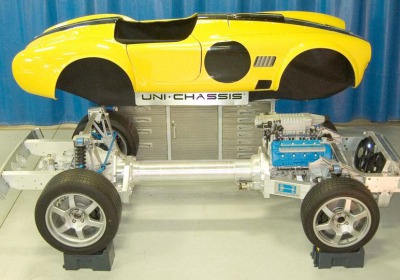Former Ford exec Theodore shows off lighter chassis at SAE
Mon, 11 Apr 2011
Automakers are facing tougher government regulations for fuel economy, and one former Ford and Chrysler executive says he has a solution
Chris Theodore, best known for his work on the Ford GT and Dodge Viper, has designed a vehicle chassis that he says will provide automakers with weight savings, cut manufacturing costs and make electric vehicles more economically viable. Theodore is showcasing his proof-of-concept Uni-Chassis at the SAE World Congress this week. It uses the powertrain and suspension of the GT, under an agreement with Ford.
Theodore says the Uni-Chassis is unique because it connects front and rear powertrain and suspension components to a rigid backbone, eliminating the frame altogether. Automobiles are usually assembled using either a unitized or a body-on-frame construction.
Theodore is presenting his design through his automotive consulting company Theodore & Associates. He will be looking for feedback from three specific manufacturing areas: specialty vehicles, plug-in hybrid-electric vehicles, and battery-electric vehicles.
Cost is critical
Jay Baron, CEO of the Center for Automotive Research in Ann Arbor, Mich., said Theodore certainly has the credentials and expertise to produce a technically sound product. However, the success of it will come down to cost, he said.
"The cost is critical. The design looks expensive and its success will be highly cost dependent," Baron said in an e-mail. "The design is clearly aimed at high-end vehicles, and not mass-produced mainstream vehicles."
One feature of Theodore's design is that instead of keeping the vehicle's battery unit in a battery pack and then reinforcing the body to support the pack, the Uni-Chassis backbone would house the battery itself. Simplifying the battery support structure translates into weight loss and better vehicle efficiency, Theodore said.
"Efficiency is always important on hybrid-electric and battery-electric vehicles because the batteries are so expensive and heavy," he said. "If it can be weight-efficient with a structure like Uni-Chassis, then that makes the business case more palatable."
Theodore spent 12 years with Chrysler as a product executive before joining Ford Motor Co. in 1999. During his time at Ford, he served as North American product chief and as vice president of advanced product creation. After retiring from Ford in 2004, he went on to become CEO of supplier ASC Inc. and later specialty-car maker Saleen Inc. He has had his own consulting firm since March 2009.
Interchangeable bodies
Another professed perk of Theodore's design is that it allows for interchangeable bodies and powertrains on the same chassis. An entire line of vehicles could be designed off the same chassis, simply by extending the backbone, Theodore said.
"A big advantage was keeping the investment low and being able to design a chassis to serve multiple masters," he said. "Here you have a fully supporting chassis that has the powertrain and everything else, and you can do custom bodies or multiple bodies on the same chassis."
For Baron, an interchangeable design like this could be valuable to automakers.
"Having the ability to re-deploy a common chassis-like structure could be an advantage and offer an opportunity to someone," Baron said.
Although it probably will cost more than a standard unibody structure, the Uni-Chassis's aluminum will cost at least 10 percent less than a typical aluminum supercar spaceframe, Theodore said.
Theodore plans to have a proof-of-concept Shelby Cobra built this year, and says low-volume production could be possible in three years. In the meantime, the Uni-Chassis will make its debut Tuesday at the SAE World Congress.
By Laur

